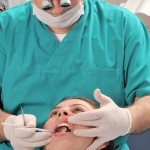
Dental caries is the worlds most prevalent preventable condition. If diagnosed and treated early in the disease process caries can be stabilised and reversed. The traditional method of detecting caries is using a visual-tactile examination often with supporting radiograph. Although early diagnosis may enable disease stabilisation using preventive or minimally invasive approaches detecting early lesions visually is challenging and the use of radiographs to detect small changes in enamel is limited.
The aim of this Cochrane review was to determine the diagnostic accuracy of different visual classification systems for the detection and diagnosis of non-cavitated coronal dental caries for different purposes (detection and diagnosis) and in different populations (children or adults).
Methods
Searches were conducted in the Medline, Embase, US National Institutes of Health Ongoing Trials Register (ClinicalTrials.gov) and the World Health Organization International Clinical Trials Registry Platform databases. Diagnostic accuracy study designs (in-vitro and in-vivo) comparing a visual classification system (index test) with a reference standard (histology, excavation, radiographs) were considered. Data was extracted independently and in duplicate using a standardised data extraction and quality assessment form based on QUADAS-2. estimates of diagnostic accuracy were determined using the bivariate hierarchical method to produce summary points of sensitivity and specificity with 95% confidence intervals (CIs) and regions, and 95% prediction regions. Indirect comparisons were used to assess the comparative accuracy of different classification systems.
Results
- 67 studies (48 in-vitro) providing 71 datasets reporting on a total of 19,590 tooth sites/surfaces were included.
- The International Caries Detection and Assessment System (ICDAS) (36 studies) and Ekstrand-Ricketts- Kidd (ERK) (15 studies) were the most commonly reported classification systems.
- Only 2 studies were considered to be at low risk of bias for all 4 domains and 15 at low risk for 3 domains.
- The individual studies demonstrated substantial variability with sensitivities ranging from 0.16 to 1.00 and specificities from 0 to 1.00.
- For all visual classification systems, the estimated summary
- sensitivity = 0.86 (95%CI; 0.80 to 0.90)
- specificity = 0.77 (95%CI; 0.72 to 0.82)
- diagnostic odds ratio (DOR) = 20.38 (95%CI; 14.33 to 28.98).
- This means that with a 28% prevalence of caries in a cohort of 1000 teeth surfaces you would expect 40 to be classified as disease free when enamel caries was truly present (false negatives), and 163 being classified as diseased in the absence of enamel caries (false positives).
- The variability of results could not be explained by tooth surface (occlusal or approximal), prevalence of dentinal caries in the sample, nor reference standard.
- The certainty of the evidence was rated as low.
Conclusions
The authors concluded: –
Whilst the confidence intervals for the summary points of the different visual classification systems indicated reasonable performance, they do not reflect the confidence that one can have in the accuracy of assessment using these systems due to the considerable unexplained heterogeneity evident across the studies. The prediction regions in which the sensitivity and specificity of a future study should lie are very broad, an important consideration when interpreting the results of this review. Should treatment be provided as a consequence of a false-positive result then this would be non-invasive, typically the application of fluoride varnish where it was not required, with low potential for an adverse event but healthcare resource and finance costs.
Despite the robust methodology applied in this comprehensive review, the results should be interpreted with some caution due to shortcomings in the design and execution of many of the included studies. Studies to determine the diagnostic accuracy of methods to detect and diagnose caries in situ are particularly challenging. Wherever possible future studies should be carried out in a clinical setting, to provide a realistic assessment of performance within the oral cavity with the challenges of plaque, tooth staining, and restorations, and consider methods to minimise bias arising from the use of imperfect reference standards in clinical studies.
Comments
This diagnostic test accuracy review of visual or visual-tactile examination and has been undertaken following standard Cochrane Diagnostic Test Accuracy (DTA) and is one of a suite of reviews using the same generic protocol. Previous reviews have covered radiographs and imaging (Dental Elf – 19th Mar 2021), light-based tests (Dental Elf – 1st Feb 2021) and fluorescence devices (Dental Elf – 6th Jan 2021) and electrical conduction devices (Dental Elf – 22nd Mar 2021).
This extensive diagnostic test accuracy review provides summary sensitivity and specificity points suggesting that visual classification systems are reasonable at detecting early caries. However, the prediction regions are very broad as a result of unexplained heterogeneity. Another challenge is that 48 out of the 67 included studies were conducted in-vitro rather than a clinical setting but as the authors highlight this is likely to be the status quo until an appropriate reference standard is developed for in-vivo studies. Any future studies should be carried out in realistic clinical situations well conducted and reported using the STARD checklist .
Links
Primary Paper
Macey R, Walsh T, Riley P, Glenny AM, Worthington HV, O’Malley L, Clarkson JE, Ricketts D. Visual or visual-tactile examination to detect and inform the diagnosis of enamel caries. Cochrane Database Syst Rev. 2021 Jun 14;6:CD014546. doi: 10.1002/14651858.CD014546. PMID: 34124773.
Other references
Cochrane Oral Health Blog – Visual or visual‐tactile examination for the diagnosis of dental caries
Dental Elf – 22nd Mar 2021
Dental Elf – 19th Mar 2021
Dental imaging methods for early caries detection and diagnosis
Dental Elf – 1st Feb 2021
Dental Elf – 6th Jan 2021
Dental Elf – 30th Apr 2021
